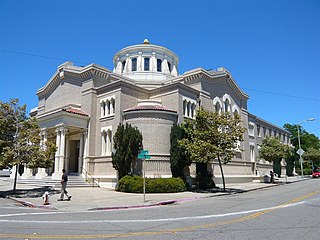
Congregation Beth Israel is a Reform Jewish congregation and synagogue located at 701 Farmington Avenue, in West Hartford, Connecticut, in the United States.

Rodef Shalom Congregation is an historic Reform Jewish congregation and synagogue located at 4905 Fifth Avenue, Pittsburgh, Pennsylvania, in the United States. The landmark building was designed by architect Henry Hornbostel and completed in the Beaux-Arts style.

Congregation Beth Elohim, also known as the Garfield Temple and the Eighth Avenue Temple, is a Reform Jewish congregation and historic synagogue located at 274 Garfield Place and Eighth Avenue, in the Park Slope neighborhood of Brooklyn in New York City, New York, United States.

Temple Sinai is a Reform Jewish congregation and synagogue located at 2808 Summit Street in Oakland, California, in the United States. Founded in 1875, it is the oldest Jewish congregation in the East San Francisco Bay region.
Congregation Beth Israel is an egalitarian Conservative synagogue located at 989 West 28th Avenue in Vancouver, British Columbia. It was founded in 1925, but did not formally incorporate until 1932. Its first rabbi was Ben Zion Bokser, hired that year. He was succeeded the following year by Samuel Cass (1933–1941). Other rabbis included David Kogen (1946–1955), Bert Woythaler (1956–1963), and Wilfred Solomon, who served for decades starting in 1964.
Beth Israel Congregation is a Reform Jewish congregation and synagogue located at 5315 Old Canton Road in Jackson, Mississippi, in the United States. Organized in 1860 by Jews of German background, it is the only Jewish synagogue in Jackson. Beth Israel built the first synagogue in Mississippi in 1867, and, after it burned down, its 1874 replacement was at one time the oldest religious building in Jackson.

Congregation Beth Israel is a Reform Jewish congregation and synagogue located at 53 Lois Street, in North Adams, Massachusetts, in the United States. The congregation was founded in the early 1890s as House of Israel by Eastern European Jews recently immigrated to the United States. The Chevre Chai Odom congregation broke away from House of Israel in 1905, but re-united with it in 1958, and the congregation adopted its current name in 1961.

Congregation Beth Israel is a Reform Jewish congregation and synagogue, located at 10460 North 56th Street in Scottsdale, Arizona, in the United States. Incorporated in 1920, the congregation affiliated with the Union for Reform Judaism in 1935.
Temple Beth Israel is a Reform Jewish synagogue located at One Bowman Street in Plattsburgh, Clinton County, New York, in the United States. Established in 1861, it initially served Plattsburgh's Jewish population and itinerant Jewish tradesmen in the region. After worshiping in temporary locations, the congregation acquired its first permanent home on Oak Street in 1866. Beth Israel adopted Reform services in 1910, and joined the Union for Reform Judaism in 1913.
Congregation Beth Israel is a Reform Jewish synagogue located at 615 Court Street, Honesdale, Pennsylvania, in the United States. Founded in 1849 by German Jews, its 1856 synagogue building was the smallest in the United States. The congregation was originally Orthodox, but rapidly moved to "Classical Reform". In the 1930s and 1940s an influx of more traditional Eastern European Jews prompted a change from Classical Reform to Traditional Reform.

Congregation Beth Israel is a Modern Orthodox synagogue located at 4004 West Esplanade Avenue, Metairie, a suburb of New Orleans, Louisiana, in the United States.
Congregation Am Tikvah is a combined Conservative and Reform Jewish congregation and synagogue located at 625 Brotherhood Way in San Francisco, California, in the United States. The congregation was formed in 2021 as the result of the merger of the Conservative B'nai Emunah and the Reform Beth Israel Judea congregations, with the latter formed in 1969 through a merger of the Conservative Congregation Beth Israel and the Reform Temple Judea. The congregation is affiliated with both the Union for Reform Judaism and the United Synagogue of Conservative Judaism.
Temple Israel is a Reform Jewish congregation and synagogue, located at 3100 East Broad Street, in Columbus, Ohio, in the United States. Founded as the Orthodox Bene Jeshurun congregation in 1846, the congregation is the oldest Jewish congregation in Columbus, and a founding member of the Union for Reform Judaism. Its first religious leader was Simon Lazarus, a clothing merchant who founded what would become Lazarus department stores.

Congregation Rodef Sholom is a Reform Jewish congregation and synagogue, located on the Lonee C. Hoytt Jewish Campus, at 170 North San Pedro, in San Rafael, Marin County, California, in the United States.

Congregation Beth Jacob Ohev Sholom is an Orthodox Jewish synagogue located at 284 Rodney Street in Williamsburg, Brooklyn, in New York City, New York, United States. The congregation follows the Ashkenazi rite.
The city of Cumberland, Maryland is home to a small and declining but historically significant Jewish community. The city is home to a single synagogue, B'er Chayim Temple, one of the oldest synagogues in the United States. Cumberland has had a Jewish presence since the early 1800s. The community was largest prior to the 1960s, but has declined in number over the decades. Historically, the Jewish community in Cumberland maintained several synagogues, a Jewish cemetery, and a Hebrew school. By 2019, Cumberland's Jewish community had its lowest population point since the early 1900s.









